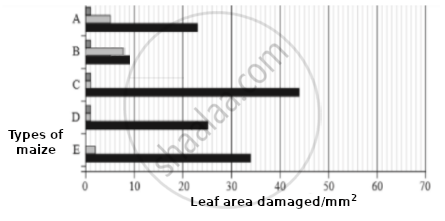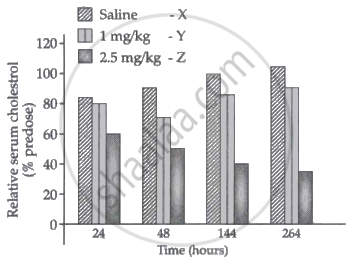Advertisements
Advertisements
प्रश्न
What is meant by the term bio-pesticide? Name and explain the mode of action of a popular bio-pesticide.
उत्तर
Biopesticide is a pesticide which is
- Not chemical in nature
- More specific in action against the pest
- Safer for the environment than chemical pesticides A popularly known bio-pesticide is Bt toxin, which is produced by a bacterium called Bacillus thuringiensis. Bt toxin gene has been cloned from this bacterium and expressed in plants. Bt toxin protein when ingested by the insect, gets converted to its active form due to the alkaline pH of the gut. The activated toxin binds to the surface of midgut epithelial cells and creates pores that cause cell swelling and lysis and eventually kill the insect.
APPEARS IN
संबंधित प्रश्न
Why do lepidopterans die when they feed on Bt cotton plant? Explain how does it happen.
In the following questions/statements has four suggested answers. Rewrite the correct answer
Bt cotton is resistant to:
(A) Insects
(B) Herbicides
(C) Salt
(D) Drought
What are biofertilizers? Describe their role in agriculture. Why are they preferred to chemical fertilizers?
A protoxin is ______.
Bt cotton is resistant to pest, such as lepidopteron, dipterans and coleopterans. Is Bt cotton also resistant to other pests as well?
You have identified a useful gene in bacteria. Make a flow chart of the steps that you would follow to transfer this gene to a plant.
Insects in the Lepidopteran group lay eggs on maize crops. The larvae on hatching feed on maize leaf and tender cob. In order to arrest the spread of three such Lepidopteran pests, Bt maize crops were introduced in an experimental field.
A study was carried out to see which of the three species of lepidopteran pests was most susceptible to Bt genes and its product.
The lepidopteran pests were allowed to feed on the same Bt-maize crops grown on 5 fields (A-E).
The graph below shows the leaf area damaged by these three pests after feeding on maize leaves for five days.

Key for lepidopteran insect pest species
 |
Species I |
 |
Species II |
 |
Species III |
Insect gut pH was recorded as 10, 8 and 6 respectively for Species I, II and III respectively.
(a) Evaluate the efficacy of the Bt crop on the feeding habits of the three species of stem borer and suggest which species is least susceptible to Bt toxin.
(b) Which species is most susceptible to Bt-maize, and explain why?
(c) Using the given information, suggest why a similar effect was not seen in the three insect species.
|
RNA interference (RNAi) holds great potential as a therapeutic agent for the treatment of human diseases and as biocontrol agents in controlling pests in the field agriculture. An experiment was carried to study the use of 'RNAi' for the potential treatment of disorders of cholesterol metabolism. Some people possess genetic mutations with elevated levels of ApoB gene which predisposes them to coronary artery diseases. Lowering the amount ApoB can reduce the number of lipoproteins and lower the blood cholesterol. Tracy Zimmerman and her colleagues used RNAi in 2006 to reduce the level of ApoB in non human primates Cynomolgus monkeys. One group of monkeys were given RNAi treatment (small interfering RNAs, SiRNAs) (doses 1 mg/kg, SiRNAs), second group of monkeys were given RNAi treatment (doses 2.5 mg/kg, SiRNAs) and third group of monkeys were injected with saline. |
The results of the study are depicted in the graph below:

- How does the treatment with 2.5 mg/kg bring an effect on cholesterol metabolism when compared from 24 hours and 144 hours?
- Write any two natural sources from where dsRNA molecule could be obtained for silencing the specific mRNA.
- How is RNAi used in controlling the infection on the roots of tobacco plants by the nematode Meloidogyne incognitia?
On spraying Bacillus thuringiensis on an infected cotton crop field the pests are killed by the toxin, however the toxin although produced by the bacteria does not affect it. Explain giving reason.
Compare and contrast the disadvantages of production of genetically modified crops.
